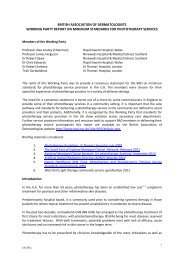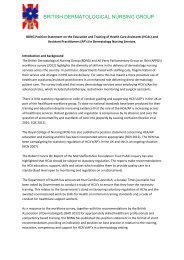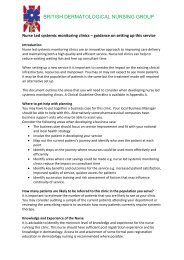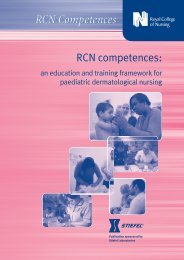Improving outcomes for people with skin tumours including melanoma
Improving outcomes for people with skin tumours including melanoma
Improving outcomes for people with skin tumours including melanoma
Create successful ePaper yourself
Turn your PDF publications into a flip-book with our unique Google optimized e-Paper software.
<strong>Improving</strong> Outcomes <strong>for</strong><br />
People <strong>with</strong> Skin Tumours<br />
<strong>including</strong> Melanoma<br />
Management of special<br />
groups<br />
All patients in high-risk groups <strong>with</strong> precancerous <strong>skin</strong> lesions (e.g.<br />
multiple warty lesions and/or AK) should be referred early to a<br />
dermatologist <strong>for</strong> assessment, active treatment and follow-up.<br />
Once patients at high risk start to develop <strong>skin</strong> lesions they should be<br />
offered at least 6-monthly follow-up.<br />
Genetic predisposition<br />
Patients <strong>with</strong> evidence of genetic predisposition and their families<br />
should be offered referral to the clinical genetics services or a<br />
specialist dermatology service. The criteria <strong>for</strong> referral <strong>for</strong> families <strong>with</strong><br />
MM are:<br />
• three or more family members <strong>with</strong> MM, or<br />
• two first-degree relatives <strong>with</strong> MM, or<br />
• two relatives <strong>with</strong> MM, one of whom had multiple primaries.<br />
6<br />
Patients <strong>with</strong> familial MM, Gorlin’s syndrome or XP should be<br />
reviewed by SSMDTs and be managed by dermatologists and surgeons<br />
who have expertise in these conditions.<br />
Patients <strong>with</strong> Gorlin’s syndrome should not be treated <strong>with</strong><br />
radiotherapy.<br />
Transplant patients<br />
Transplant patients who have precancerous <strong>skin</strong> lesions or who have<br />
developed a <strong>skin</strong> cancer should be seen in a dedicated ‘transplant<br />
patient <strong>skin</strong> clinic’, either in the transplant centre or in a hospital<br />
closer to the patient’s home, according to the choice of the patient.<br />
Close links should be established between the transplant centre, local<br />
physician and dermatologist <strong>for</strong> the management of transplant patients<br />
postoperatively.<br />
Dermatologists managing transplant recipients <strong>with</strong> multiple and/or<br />
recurrent <strong>skin</strong> cancers need to liaise <strong>with</strong> the transplant team<br />
regarding reduction of immunosuppression and the use of systemic<br />
retinoids in order to reduce the risk of invasive disease.<br />
118<br />
National Institute <strong>for</strong> Health and Clinical Excellence















